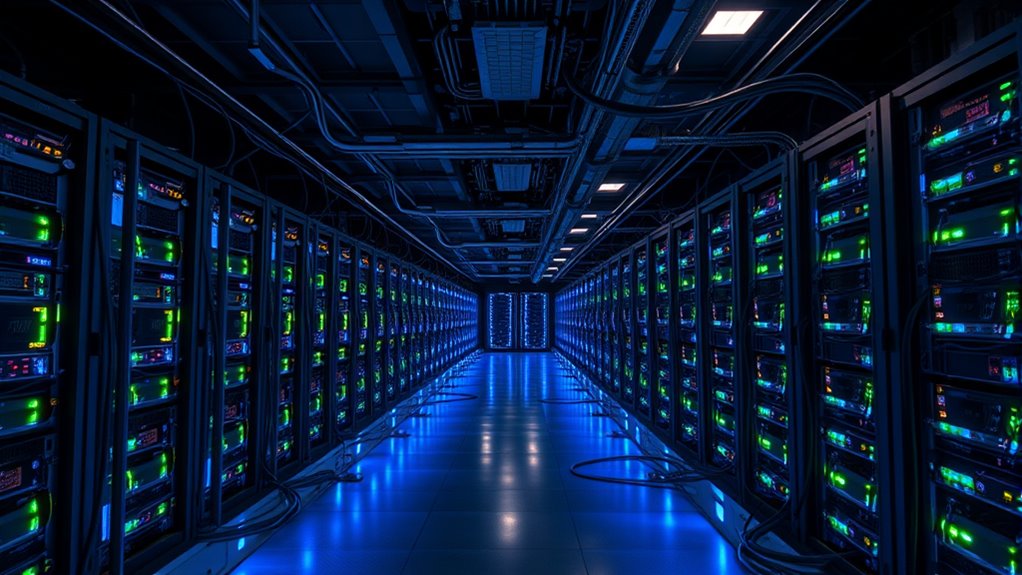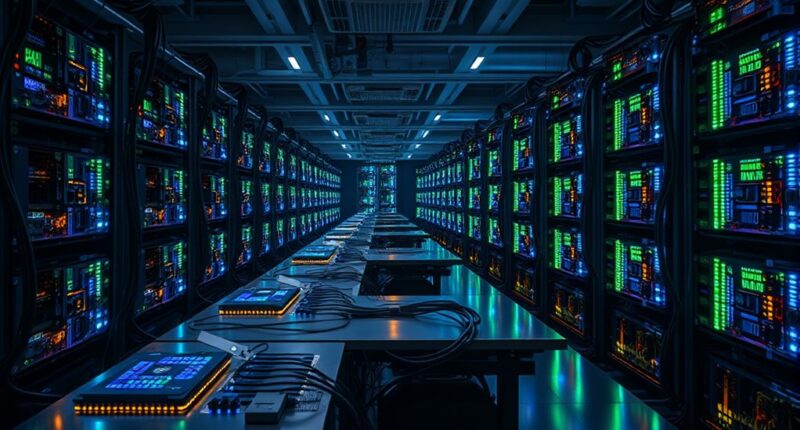Bitcoin mining is how new bitcoins are created and transactions are added to the blockchain. You use specialized hardware, like ASIC devices, to solve complex mathematical puzzles that validate transactions. When you successfully complete a puzzle, you earn new bitcoins as a reward. This process keeps the network secure and trustworthy. To learn more about the mechanics and requirements of bitcoin mining, keep exploring how this fascinating system works.
Key Takeaways
- Bitcoin is created through a process called mining, which involves validating transactions and adding them to the blockchain.
- Miners solve complex mathematical puzzles using specialized hardware (ASICs) to secure the network and earn new BTC.
- The creation of new Bitcoin, called “block rewards,” occurs approximately every 10 minutes as miners successfully validate a block.
- The number of new BTC generated decreases over time through scheduled “halving” events, reducing the block reward.
- Mining difficulty adjusts regularly to maintain a consistent rate of new block creation despite changing network conditions.

Bitcoin mining is the process of validating and adding new transactions to the blockchain, which is the decentralized digital ledger that underpins Bitcoin. This process involves solving complex mathematical puzzles using specialized hardware, guaranteeing that transactions are securely recorded and the network remains trustworthy. As you explore mining, you’ll quickly realize that the landscape is shaped by evolving cryptocurrency regulations and rapid mining hardware advancements. These factors directly influence how profitable and accessible mining can be.
Cryptocurrency regulations are a vital consideration because they dictate what you can and can’t do within your jurisdiction. Some countries impose strict rules or outright bans on mining activities, citing concerns over energy consumption or financial security. Others have more permissive policies, encouraging innovation and investment. Staying informed about these regulations helps you avoid legal pitfalls and guarantees your mining operations comply with local laws. Additionally, regulations can impact your costs, taxes, and the overall viability of your mining setup. As governments continue to refine their policies, you might see new restrictions or incentives that could affect your profitability.
Alongside legal considerations, mining hardware advancements are transforming the entire process. In the early days of Bitcoin, you could mine with a regular computer CPU, but that’s long changed. Today, most miners rely on powerful ASIC (Application-Specific Integrated Circuit) devices designed solely for cryptocurrency mining. These specialized machines offer vastly higher hashing power and energy efficiency, making them essential for competitive mining operations. As technology progresses, newer hardware emerges that reduces energy consumption and increases output, which is vital given the high costs associated with electricity and hardware investments.
The evolution of mining hardware also means that the barrier to entry becomes more expensive. High-performance ASICs come with hefty price tags, and keeping up with the latest advancements requires significant capital. However, investing in cutting-edge hardware can lead to higher chances of earning Bitcoin, especially when paired with optimized setups and strategic mining pools. As hardware improves, the challenge shifts from mere access to the best equipment to managing operational costs and maximizing efficiency. This ongoing race influences the overall landscape, making it essential for you to stay updated on technological developments and regulatory changes to remain competitive in Bitcoin mining.
Frequently Asked Questions
What Is the Environmental Impact of Bitcoin Mining?
You should know that bitcoin mining markedly impacts the environment by increasing your carbon footprint, especially when powered by fossil fuels. However, if miners switch to renewable energy sources, they can reduce this impact considerably. Using cleaner energy not only cuts emissions but also makes bitcoin mining more sustainable. By supporting or advocating for renewable energy use in mining operations, you help lessen environmental harm and promote a greener future.
How Do Mining Pools Work Together?
You join a mining pool where members work together through pool coordination, combining their computing power to solve blocks faster. When the pool successfully mines a block, rewards are shared among members based on their contributed hashing power. This collaborative approach increases chances of earning rewards regularly, even if individual efforts alone might not succeed often. Pool coordination and reward sharing keep everyone motivated and fairly compensated for their mining contributions.
Can Anyone Start Mining Bitcoin Today?
Yes, you can start mining Bitcoin today, but you should first check local mining regulations to guarantee compliance. Conduct a profitability analysis to determine if mining is worth your investment, considering costs like hardware, electricity, and cooling. Keep in mind that mining difficulty fluctuates, affecting your potential rewards. If everything aligns, you can join a mining pool or mine solo, but always stay updated on legal and financial factors.
What Hardware Is Most Efficient for Mining?
Did you know that ASIC miners can be up to 100 times more efficient than GPUs? For mining, ASICs are the best choice because of their superior efficiency, especially when considering ASIC efficiency. GPUs still perform well for other tasks, but when it comes to mining, investing in an ASIC provides higher hash rates and lower energy costs, making your setup more profitable and sustainable.
How Does Bitcoin’s Difficulty Adjustment Happen?
You notice Bitcoin’s difficulty adjustment happens roughly every two weeks to maintain blockchain security. When hash rate fluctuations increase or decrease, the network automatically adjusts the mining difficulty up or down to keep block times around ten minutes. This process guarantees the blockchain remains secure and consistent, preventing malicious attacks and accommodating changes in miner participation, so the network stays reliable regardless of hardware or hash rate shifts.
Conclusion
Now that you know the secrets behind Bitcoin mining, you’re practically a digital gold prospector! With every block you help mine, you’re opening a treasure chest of new BTC—more than you could ever imagine. It’s like holding the key to a secret vault of endless riches. So gear up, plunge into, and start your journey—because in the world of Bitcoin mining, the possibilities are absolutely mind-blowing!








